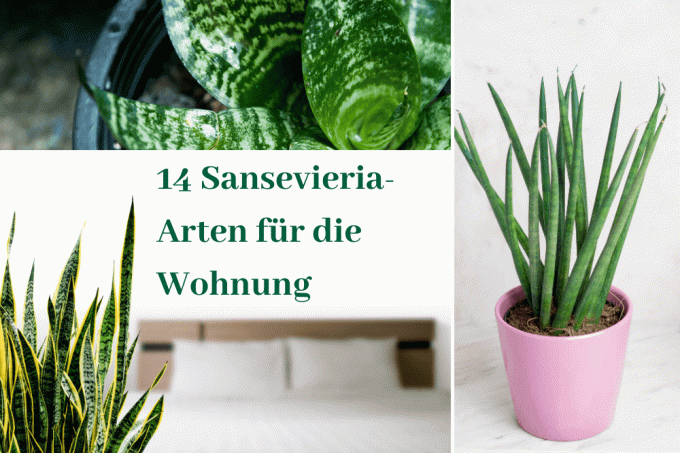
table of contents
- S. bacularis
- S. burmanica
- S. concinna
- S. cylindrica
- S. francisii
- S. hyacinthoides
- S. Liberia
- S. longiflora
- S. parva
- S. raffillii
- S. senegambica
- S. subspicata
- S. trifasciata
- S. zeylancia
Of the Bow hemp seemed almost forgotten for a while before it was rediscovered as an ornamental plant a few years ago. What makes it so special is not least its somewhat bizarre appearance and the special drawing of the leaves. In addition, the easy maintenance of succulents. There are over 70 different species of Sansevieria. We have compiled the most interesting in the list below.
S. bacularis
This bow hemp has leaves up to 170 cm long. They are dark green in color with light transverse bands. The leaf tips are soft. The white flowers appear in spring and have a purple stripe through them.

- warm and bright location
- Moving outdoors in summer
- water a little
- tolerates short dry periods
- not hardy
- give before the first frosts
S. burmanica
The home of the plants is in India. Up to 13 upright, linear-lanceolate leaves stand together in a rosette. They reach a length between 45 and 75 centimeters and are colored grass green with light bands. There are up to three vertical stripes on the smooth upper side of the leaf. The leaf margin is green. It can turn white with age. Greenish-white, panicle-like inflorescences with a length of 60 to 75 centimeters appear.
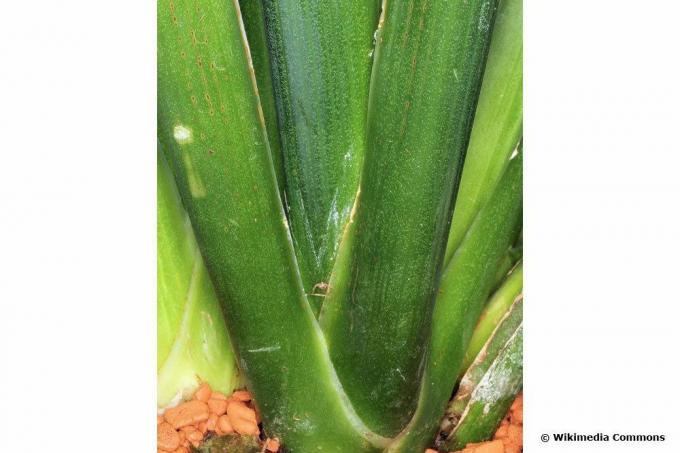
- sunny to partially shaded location
- Temperature 20 ° C
- not below 14 ° C
- pour moderately
- less watering in winter
- 14 days of fertilization in summer
- Substrate: potting soil with a high proportion of sand
S. concinna
This Sansevieria species comes from South Africa. The upright, lanceolate leaves grow from a thick rhizome and stand together in a rosette. They reach a length between 15 and 25 centimeters and are colored green with pale green transverse bands. The leaf surface is smooth and the edge is not hardened. Spike-shaped, white inflorescences appear. They can be between 15 and 30 centimeters long.
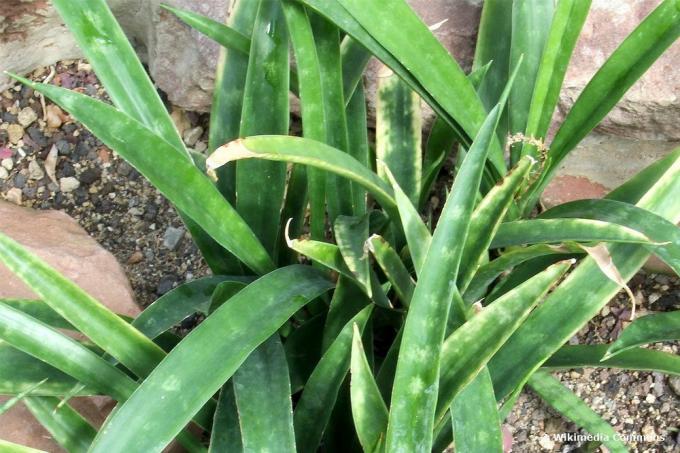
- shady location
- Temperature all year round 20 ° C
- pour moderately
- no waterlogging
- Let the soil dry out a little
- Fertilize from spring to autumn
- Substrate: slightly sandy
S. cylindrica
This Sansevieria species originally comes from South Africa. It is not very common. The columnar, upright leaves can be up to a meter long and 2 to 3 centimeters thick. They are green to grayish in color. Young plants often have dark green transverse bands. The leaves often become a bit furrowed with age. There are various cultivated forms of this bow hemp such as "Spaghetti", "Skyline" or "Patula".
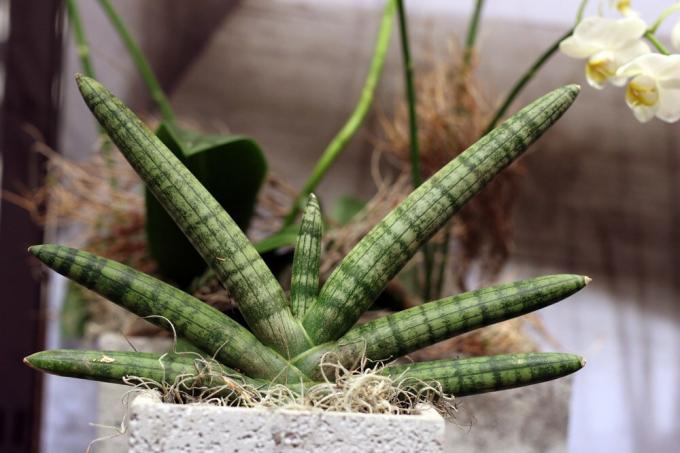
- lots of light
- sunny location
- outdoors in summer
- water evenly
- tolerates short dry periods
- at least 60% humidity
- Temperature 20 ° C
- Fertilize from spring to autumn
- Cactus fertilizer
- Liquid fertilizer for succulents
S. francisii
This bow hemp originally comes from Kenya and grows trunk-shaped with upturned leaves. The height is 30 centimeters. These are marbled from dark to light green and taper to a point. The plants form runners with various daughter plants. These can be used to propagate cuttings.

- sunny to partially shaded location
- also tolerates blazing sun
- pour little
- let the soil dry out beforehand
- no waterlogging
- Fertilize from spring to autumn
- Temperature all year round 20 ° C
- not below 15 ° C
- Substrate: cactus soil
- Mixture of potting soil, fine sand, clay granules
- Propagation: leaf cuttings, runners
S. hyacinthoides
As the name suggests, the "African bow hemp" comes from Africa. There it grows in dense, small groups in the shade of the trees. The leaves can reach a length of 120 centimeters. They are medium green in color with dark green transverse bands, very broad and on short stems. They stand together loosely in a broad rosette. The plant forms long rhizomes.
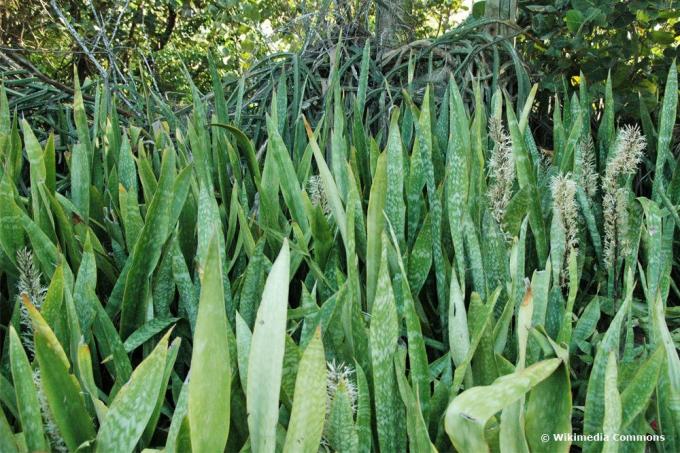
- sunny to shady location
- at least 4 hours of sun a day
- Temperature 20 to 30 ° C
- pour moderately
- permeable substrate
S. Liberia
This Sansevieria species originally comes from the Central African Republic and West Africa. Up to six belt-shaped to lanceolate, leather-like leaves stand together on one shoot. Their growth is almost upright. They can be 45 to 110 centimeters long and are dark green in color with pale green transverse bands. The end of the leaf is slightly tapered and colored white with age. The somewhat cartilaginous leaf margin is slightly reddish brown. White flowers are loosely arranged in panicles. The flower stem can be between 60 and 80 centimeters high.
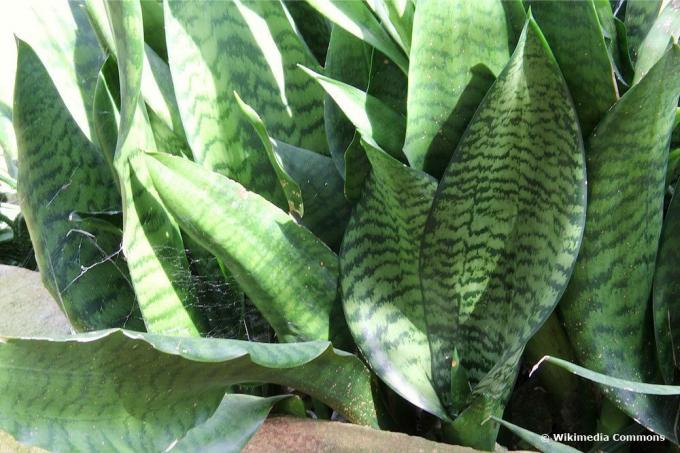
- prefers shady locations
- pour little
- no waterlogging
- Let the earth dry calmly
- Temperature 20 to 30 ° C
- Substrate: well drained, dry, somewhat granular
S. longiflora
His homeland is also Africa. There this bow hemp grows primarily in Angola, Namibia and the Congo. The dark green leaves are lightly spotted or irregularly banded with a smooth leaf surface. They reach a length of 150 centimeters and are between 3 and 9 centimeters wide. There is a 3 to 6 millimeter long brown spine at the tip of the leaf. The leaf margin is hardened and colored red-brown to yellowish. White panicle-like flowers appear.
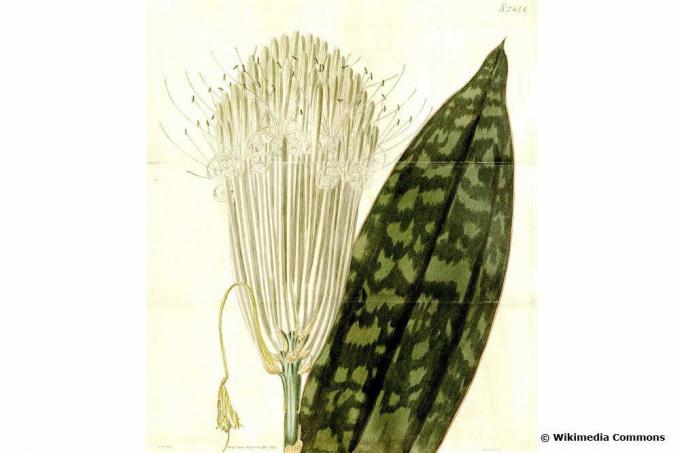
- sunny to shady location
- pour moderately
- no waterlogging
- rather let it dry out a bit
- Temperature 20 to 30 ° C
- Substrate: sandy and well drained
S. parva
This Sansevieria species mainly grows in Kenya, Uganda and Rwanda. The dark green leaves with dark or lighter transverse bands are linear to lanceolate. White to pink flowers appear. The plants are quite easy to care for. They are very suitable for beginners.
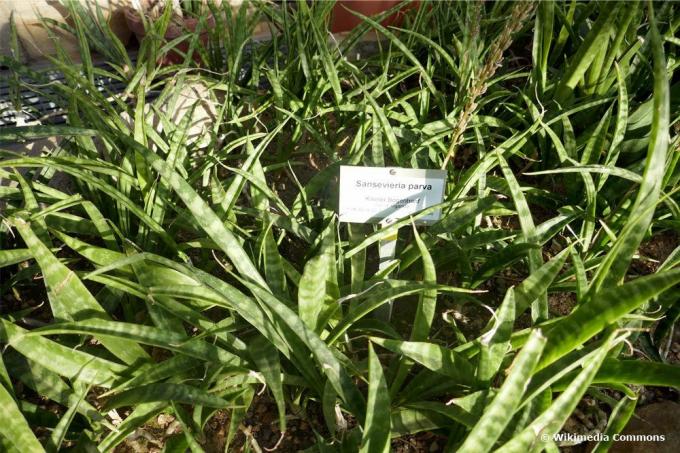
- lots of light
- sunny location
- also tolerates partial shade
- Temperatures 20 to 30 ° C
- Substrate: somewhat granular and permeable
- pour little
S. raffillii
This Sansevieria species is native to Kenya and Somalia. Up to five centimeters thick rhizomes grow upright, lanceolate leaves with a length of up to 150 centimeters and a smooth leaf surface. Yellowish-green spots or irregular transverse bands are present on the green leaf base. The markings may fade on older plants. The leaf margin is hardened and colored reddish-brown. The inflorescences are panicle-shaped and greenish-white in color. They reach a length of 90 and 120 centimeters.
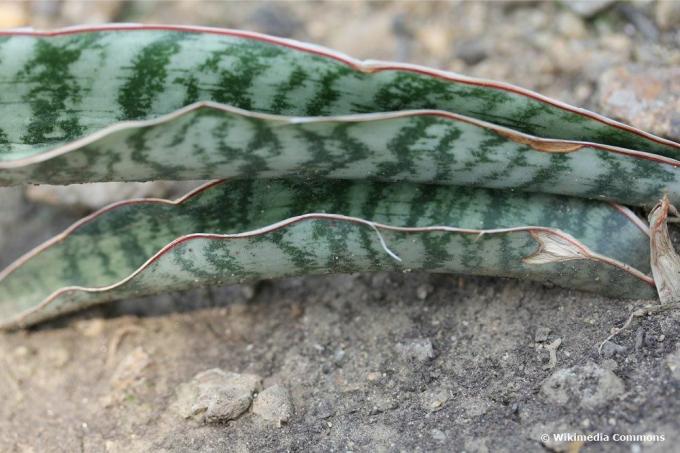
- shady location
- water sparingly
- Avoid waterlogging
- Temperature 20 to 25 ° C
- Substrate: loose, well drained, sandy
S. senegambica
His home is in West Africa. Up to four leaves are loosely arranged in a rosette. They grow upright, taper to a point and bend back slightly. The leaf surface is dark green in color with barely visible transverse bands. The underside is brighter, but the transverse bands are clearly visible. The leaf length is 40 to 70 centimeters. The leaf margin is green. The white flowers stand together in panicles. They glow purple in the sun. The flower stems are 30 to 50 centimeters long.
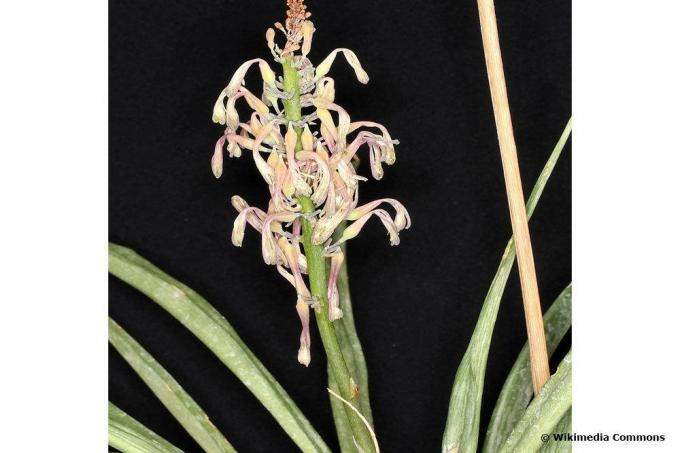
- prefers a shady location
- pour moderately
- no waterlogging
- Temperature 20 ° C
- Substrate: permeable and loose
S. subspicata
This bow hemp originally comes from Mozambique. The lanceolate leaves grow upright and are slightly bent back. They have a length of 20 to 60 centimeters, taper to a point and are green to slightly bluish in color. The leaf margin is green and discolored white with age. The greenish-white flowers stand together in panicles. The inflorescences are 30 to 40 centimeters high.
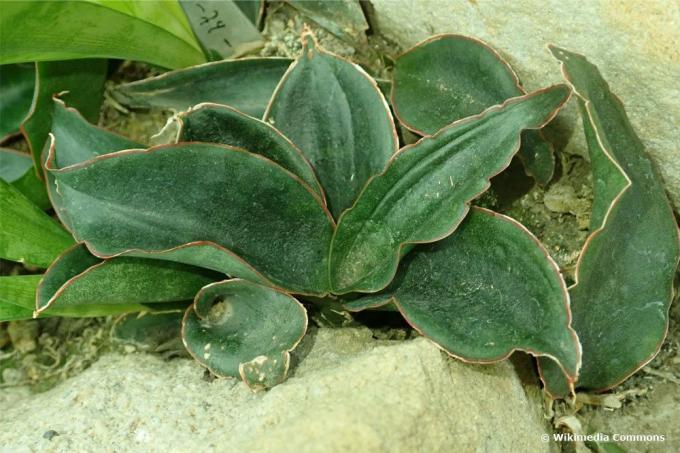
- sunny to partially shaded location
- pour little
- no waterlogging
- Temperature 20 to 25 ° C
- Substrate: slightly sandy, loose and permeable to water
S. trifasciata
This is probably the best-known Sansevieria species. It comes from tropical West Africa. In this country it is also known as the snake plant or mother-in-law's tongue. Linear-lanceolate leaves grow from creeping rhizomes. They reach lengths of 40 to 60 centimeters and are grass green with white to light green transverse bands. The cultivar “Laurentii” with golden yellow longitudinal stripes along the leaf margins is very popular. There are various cultivated forms of this species such as the "Hahnii" with brightly colored, rosette-shaped, funnel-shaped leaves or the "Golden Flame" with golden yellow stripes. This bow hemp grows particularly well in pots that are a little too narrow.

- sunny to partially shaded location
- no blazing sun
- Temperature 20 ° C, not below 14 ° C
- keep moderately moist
- tolerates drought for a short time
- Avoid waterlogging
- Substrate: potting soil with 50% loamy and sandy additives
- Fertilize from spring to autumn
- Cactus fertilizer
- Liquid fertilizer for succulents
- Propagation: seeds, leaf cuttings, daughter rosettes
S. zeylancia
This Sansevieria species is native to Sri Lanka. There the bow hemp grows in sandy and rocky dry areas. They have an upright habit and can reach a height of 60 to 70 centimeters. The green-white leaves are somewhat leathery. Green, slightly wavy lines run through the leaf surface. The plants form a flat root system. Repotting is only necessary if the roots threaten to blow up the pot. Then the plant can also be divided.
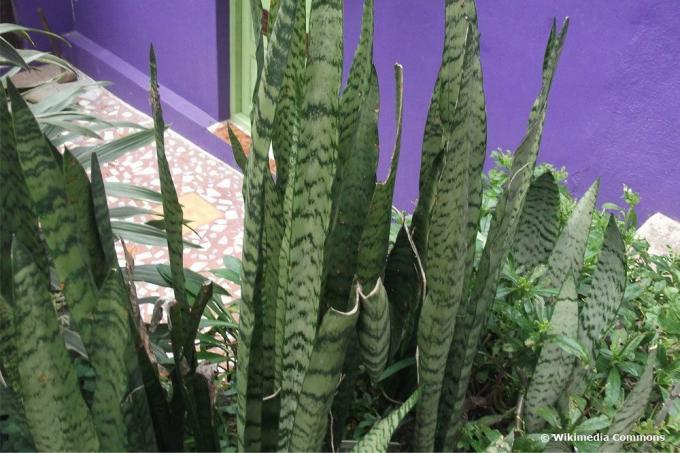
- sunny to partially shaded location
- pour little
- Soil should be completely dry
- Fertilize once a month
- Cactus fertilizer
- Liquid fertilizer for succulents



